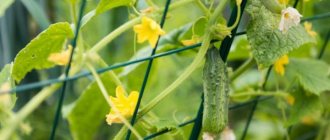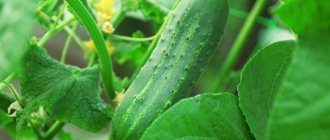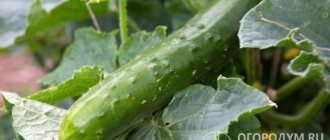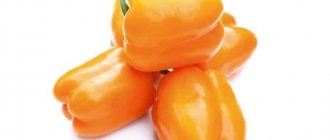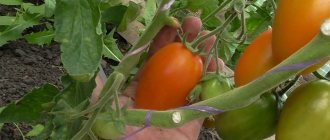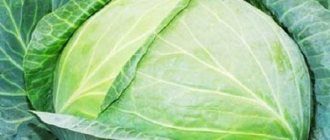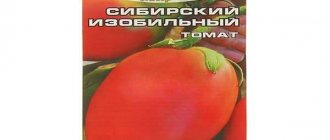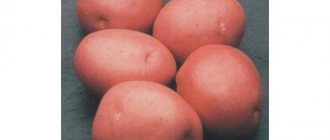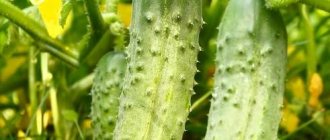In recent decades, Russian vegetable growers have increasingly grown cucumbers of Dutch selection in their garden beds and greenhouses. This happens because these varieties and hybrids of cucumbers are distinguished by excellent yields, resistance to diseases and pest attacks. Cucumbers of Dutch selection acclimatize well in most Russian regions.
One of the remarkable representatives of Dutch cucumber varieties is the Satina hybrid, which was officially tested in Russia and included in the State Register.
History of variety development
Photos of Satina cucumbers and reviews
This cucumber hybrid was bred by Dutch breeders from the famous breeding and seed company Nunhems BV Cucumber Satina F1 is a relatively new hybrid, it was bred by the Dutch in 2007, and a couple of years after the variety tests were included in the State Register of Russia .
What does hybrid F1 mean?
This vegetable crop is successfully grown in the south of Russia, in all regions of the Volga region and in the North Caucasus. However, according to reviews from vegetable growers, the Satina F1 variety grows well in the middle zone and other Russian regions with similar climatic conditions. If the weather conditions in the regions are more severe (for example, in Siberia or the Urals), then the Satin cucumber can be grown in greenhouse conditions or under film coverings.
Related article:
Secrets of July sowing of cucumbers
Description
This variety is classified as an early ripening hybrid, because no more than 1.5 weeks pass from the moment the seeds germinate until the first greens are harvested.
Although this cucumber hybrid is indeterminate, its vines do not grow too long - no more than 1.6-1.8 m. The shoots do not branch too much, their foliage is average. The foliage is large, three-lobed, with well-defined veins, slightly wrinkled, pubescent, rough and prickly to the touch. But when a sufficient amount of fertilizer is applied to cucumber bushes, the leaves become softer. Their color is deep emerald.
The cucumber hybrid Satina is parthenocarpic, which means that its flowers do not require pollination, so they grow and bear fruit well in greenhouse conditions. Almost only female type flowers are formed on its cucumber vines, and there are practically no barren flowers. The flowers are small, yellow in color.
Related article:
Growing cucumbers: in a barrel, hut and on a trellis
The ovaries are formed in the axils of the leaves, usually one at a time, rarely 2 or more.
Mature greens have a regular cylindrical shape, all fruits are approximately the same shape and weight. Their length can be 9-12 cm. However, the fruits are mainly picked at the gherkins or pickles stage - in this case the fruits will be more tender and juicy.
The skin of these cucumbers is thin, without crunch, with large tubercles and light thorns. It also has pubescence - light. The color of the skin is dark emerald, with short light stripes and vague spots.
Thanks to the efforts of breeders, there is absolutely no bitterness in the taste of ripe gherkins. There are no voids in the juicy, compacted pulp, and it has a wonderful crunch.
Related article:
How to grow good cucumbers in a greenhouse
Cucumber Satina
The average weight of harvested cucumbers is about 90-105 g. Moreover, approximately half of the harvest ripens in the first wave - 1.5 months after the sprouts appear, and the remaining greens are harvested gradually over the following summer months.
The presentation of harvested greens is excellent, they can be transported to any distance, so the Satina hybrid is successfully grown not only in private farmsteads, but also on an industrial scale for further sale.
Farmer reviews
The hybrid has earned the trust of not only gardeners, but also buyers of finished products. It is not difficult to grow the crop, and ready-made cucumbers are sold at markets at an affordable price.
Lyudmila, Saransk: “ I liked the hybrid because it can be pickled in all sorts of ways. Care during the growing season is simple: just water, loosen, weed and feed on time. I buy Satin cucumber seeds at a seed store at a reasonable price.”
Claudia, Novocherkassk: “ Satin are my favorite cucumbers, because they are the most delicious and easiest to care for. I make fresh salads and winter preparations from ripe cucumbers. The hybrid has never failed, I always have a harvest, the cucumbers look like the photo on the package. This is not the first year I’ve been planting it, nor will it be the last.”
The main advantages of the variety
Experts include the main positive qualities of the Satin cucumber hybrid:
- its resistance to sudden temperature changes;
- cucumber vines can easily tolerate short periods of drought, as well as short-term waterlogging of the soil;
- the hybrid quickly adapts to new climatic conditions;
- this hybrid is quite compact, so more bushes of this variety can be planted in the beds;
- Satina cucumber is self-pollinating;
- greens have an excellent appearance and good taste;
- the harvested crop is of universal use;
- The hybrid is highly resistant to many diseases, so it rarely gets sick.
Related article:
Cucumber Baby mini F1 - description and characteristics of an early variety
Positive qualities and disadvantages of the variety
The main advantages of the SatinaF1 hybrid:
- Outstanding taste;
- High marketability of fruits;
- Possibility of transportation to any distance;
- Growing in any conditions;
- Parthenogenesis.
Among the disadvantages of the hybrid, it should be noted:
- Relatively low yield (compared to other indeterminate hybrids);
- Not the most reliable protection against diseases of pumpkin crops;
- High cost of seeds when it is necessary to annually update the seed fund.
- The advantages of Satina are the following characteristics:
- precocity;
- slight climbing and compactness of the bush;
- disease resistance;
- high yield of quality vegetables;
- good appearance of cucumbers;
- high transportability;
- excellent taste;
- the ability to collect small fruits (pickles and gherkins);
- productivity.
There are practically no downsides, since Satin has all the characteristics of a modern industrial grade. One can only complain about some capriciousness towards the soil, but the positive qualities overshadow such a drawback.
Landing rules
Like all Dutch cucumber hybrids, Satina does not require special efforts from vegetable growers when planting and further care. Typically, seed material is planted directly in garden beds or in greenhouses. But in the garden beds, at first it is advisable to cover the emerging sprouts with film or other non-woven material from possible return spring frosts.
When to plant cucumbers for seedlings in 2021
Growing this cucumber hybrid using the seedling method is also standard - the seeds are immediately planted in separate containers, regularly watered as the nutrient substrate dries, and fed a couple of times with nitrogen-containing fertilizers. And a couple of weeks before transplanting to a permanent place, the seedlings must be hardened off by taking them out into the fresh air and gradually accustoming the plants to outdoor conditions.
Related article:
Tricks for caring for cucumbers in a greenhouse
Cucumber seedlings
Although Satina F1 is not too capricious, it grows best in certain types of soil and requires regular fertilizing.
Rules for planting cucumbers for seedlings
It is ideal to plant cucumbers of this variety on loamy soils that allow moisture and air to pass well to the roots. And although the variety can easily tolerate slight drought and short-term soil moisture, it should not be grown in lowlands, where it is constantly damp and cool. You also need to be sure that the groundwater in the selected area does not come close to the surface of the earth, since the roots of the Satin cucumber may begin to rot if there is constant stagnation of moisture in the soil.
Photo of Satin cucumber
The area for planting cucumbers must be prepared in the fall, both in the garden and in the greenhouse. For autumn digging, humus is usually added - up to 7 kg per square of soil. And in the spring, before planting seeds, add 1 tbsp to each square of the area. l nitrogen-containing fertilizers and a couple of tbsp. l. superphosphate and potassium salt.
Correct pinching of cucumbers
Between the bushes of this variety you need to leave a distance of 0.5 m, and the width of the rows should be 0.6 m. It is better to grow this cucumber in one row, stretching a special mesh between the rows, to which the cucumber lashes will cling. And in greenhouses you can install trellises in order to tie shoots to them.
Related article:
How to get cucumbers to bear fruit before frost
In this case, Satin cucumber seeds are planted more often - at a distance of 0.2 m. And the tied lashes will not interfere with each other during the growth process, they are easier to care for and harvest.
Care and temperature conditions
Shoots appear already on the fifth day after sowing. Therefore, the pot must be placed in a place with good lighting. A lack of light will have a bad effect on the quality of future cucumbers and will lead to their stretching.
Temperature is also very important. Lack of heat can lead to the death of seedlings, so at the very beginning the temperature should not be lower than +23-25 ° C. After some time, the temperature can be lowered to +18-20. After a week, you can begin hardening. To do this, the pots are taken outside or onto an open balcony so that they get used to low temperatures. You need to start with 5 minutes a day, gradually increase the time to 20-30 minutes.
Watering and fertilizing seedlings:
- The first watering can be carried out on the fifth day from the moment of emergence. To prevent the soil from drying out during this time, it is sprayed.
- Excessive humidity should not be allowed, otherwise the root system will begin to rot.
- Fertilizing is needed if the soil has not been fertilized enough. Since the period of formation of cucumbers is short, you can do without them.
- If the need arises, it is better to use wood ash. It is very useful for both seedlings and adult bushes.
Solutions for feeding should not be concentrated, otherwise there is a risk of burning the plant. After fertilizing, water the soil with clean water and lay a layer of mulch on top.
Transplantation usually occurs on the 25th - 30th day, when the first 4-5 leaves are formed. Small holes are dug in the garden bed where the plants will be transplanted. Peat cups are lowered to a depth of 30-40 cm. But so that the edge of the container is 1 cm above the surface of the earth, after which the plants are watered with warm water.
If a plastic container was used for growing, you need to bend the edges and bottom (you can cut it first), and then “push” the plant into the hole, but first it needs to be moistened.
Further care
Satin F1 cucumbers
Further care for growing cucumbers of this variety is also not difficult. Watering should be done 1-2 times a week, and during the rainy season the amount of watering should be reduced. This is very convenient for those vegetable growers who do not have the opportunity to often come to their garden plot.
After each watering, you need to carefully loosen the soil in the root zone of the cucumber vines, while trying not to damage the roots of the plants, which are located close to the soil surface. You also need to remove all weeds from garden beds.
Related article:
Secrets of July sowing of cucumbers
Fertilizers for these cucumbers are applied at least 4 times per season with an interval of 12-14 days between them. For the first time, cucumbers are fed 2 weeks after planting cucumber seedlings in open ground. For this purpose, fertilizers containing nitrogen are used. From the beginning of flowering, fertilizing containing phosphorus and potassium should be applied to the cucumber bushes.
Growing cucumbers
Cucumber seeds begin to warm up at a temperature of 30-35 degrees a month before sowing:
- A very significant moment is lighting. In order to prevent the sprouts from stretching after germination, the seedlings should be given constant illumination for 3 days.
- After sowing the seeds, keep the temperature at 26-28 degrees.
- After germination, the temperature is reduced to + 20-22, if the seedlings are stretched, then to + 16.
- Below + 16, cucumber seedlings are not grown.
Cucumber seedlings are grown for a short time, generally 25-30 days. For this reason, it is very important to think about the date of sowing seeds for seedlings, focusing on the date of planting cucumbers for permanent residence. For absolutely everyone these terms are different, depending on the area of cultivation.
For example, if you are going to plant cucumber seedlings for permanent residence on May 1, then you need to sow the seeds to obtain high-quality seedlings on April 1.
There are seeds, there is packaging and all you need to do is add soil. A cucumber plant is unlikely to grow in any quality soil; most likely, it will not grow at all and will disappear as a result.
We recommend soil mixture recipes for cucumber seedlings:
- Manure and lowland peat are dark in color in the same scale.
- Turf soil 30%, humus 30%, fertilizer 30% and rotted sawdust 10%.
- Peat 30%, humus 50%, rotted sawdust 20%. Add 1 tablespoon of spring-summer fertika and 2 tablespoons of dried soft deoxidizing agent to the container of any soil mixture you choose and stir thoroughly.
Sowing seeds in boxes is the worst option:
- Despite the numerous advice on sowing cucumbers in boxes, this should not be done, since, even with the most careful picking, you will cause significant injuries to the seedlings, partly cutting off their more significant suction roots.
- Directly for this reason, seedlings must be grown in individual seedling containers (glasses).
- However, it is easiest to grow cucumber seedlings in cylinders without a bottom, made from available material, for example, glasses made of polyethylene film 200 microns wide, or a ready-made sleeve made of film, or it is possible to roll up glasses for seedlings from the narrowest substrate under the laminate.
Seedling cylinders (glasses) are filled with soil consistency, moistened with warm substance of diluted fertilizer:
- The ideal is either liquid Agricola for cucumbers or another complex fertilizer, diluted according to the instructions.
- Next, specialized seeds (warmed up for at least 30 days) are laid directly on the surface of the soil and sprinkled with a rich mixture in a layer of 1-1.5 cm.
- The base is not watered from above, but only sprinkled with hot water so that the seeds are not drawn deeper. Cover with film.
- Seedlings should not feel severe restrictions on the size of the soil for their roots. Directly for this reason, as the seedlings grow, the pots are placed from the moment the leaves touch.
- The ideal size of a pot for seedlings during this period is no less than 0.5 liters. It is necessary to place them wider after the entrances (as the seedlings grow) to prevent stretching.
- Before planting in the ground, the seedlings need to be fed 2-3 times (mixed cucumber loves to eat).
If you do not want your cucumbers to be attacked by pests, which are considered carriers of diseases, after planting in greenhouses, then 3-4 days before planting cucumber seedlings for permanent residence, it is necessary to carry out preventive watering of the soil in seedling containers from spider mites and other pests .
According to the instructions, a systemic drug is diluted, for example: “Aktara” or “Apache” and the substance is spilled on the seedlings.
prodachnika.com
Landing technology
The technology for planting and growing this variety is not much different from others and is characterized by ease of implementation. The key advantage of growing satin cucumber varieties is that there is no need to pollinate the plant.
Satin cucumbers have only one factor to which they are demanding - the quality of the soil in which they are grown. It is desirable that the soil be medium loamy. It is this soil that has good breathability. It will be great if cucumbers are planted in a place where potatoes, onions, peppers or cabbage were previously grown.
Before planting the seeds, they need to be treated with a manganese solution. To do this, take 1 g of the product and dilute it with 200 ml of water. After this, the seeds are dipped into the resulting solution for 20 minutes.
This allows you to disinfect the seeds and protect them from pests, as well as make them more resistant to diseases.
The soil must be pre-treated with a solution of potassium permanganate. To do this, you need to prepare 5 g of manganese per 10 liters of water and mix. In addition, it is necessary to remove all weeds from the soil and loosen the soil where Satina is planned to be planted.
When planting in a greenhouse, you need to follow a 60x15 cm pattern. If you plan to grow plants in open soil, a 60x60 cm pattern will suit you. Cucumbers must be planted using a trellis.
The length of one row should be about 70 cm. The soil must be regularly fed with mineral and organic fertilizers. It is recommended to maintain a distance of 1-1.5 m between the rows. The height of the pillars should be approximately 2-2.5 m. A wire is stretched between them, onto which a plastic film is attached.
Bushes sprout from seedlings, so it is necessary that cucumbers grow on soil heated to +25 ºC. If you are going to plant seeds directly in the beds, you need the soil to be no colder than +13ºС. It is not recommended to bury seeds more than 3 cm into the ground.
moefermerstvo.ru
